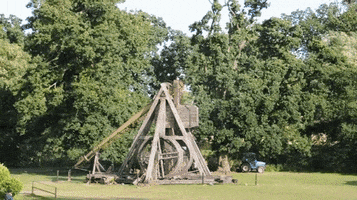Brewing and Fermentation
-
SuburbanFarmer

- Posts: 25484
- Joined: Wed Nov 30, 2016 6:50 am
- Location: Ohio
Re: Brewing and Fermintation
Not sure that’ll be enough air to feed your yeast. But curious to find out.
-
Speaker to Animals

- Posts: 38685
- Joined: Wed Nov 30, 2016 5:59 pm
Re: Brewing and Fermintation
I just stirred it and it fizzed up, so I think it is happening.
-
Speaker to Animals

- Posts: 38685
- Joined: Wed Nov 30, 2016 5:59 pm
Re: Brewing and Fermintation
Steven Seagall has some high-class instruction on how to make Viking blood mead:
Personally, I'd skip the paint bucket and go with something food grade, but solid presentation.
Personally, I'd skip the paint bucket and go with something food grade, but solid presentation.
-
Montegriffo

- Posts: 18852
- Joined: Wed Nov 30, 2016 7:14 am
Re: Brewing and Fermintation
Yeast doesn't actually need air to grow. In the absence of air it just slows down. A cloth is ideal for covering the mash as it will keep dust and insects out while letting air in. A loose fitting lid will still allow plenty of air in though.SuburbanFarmer wrote: Sun Jul 14, 2019 9:55 am Not sure that’ll be enough air to feed your yeast. But curious to find out.
The main factor in the fermentation speed is temperature.
Slow fermentation is not a bad thing though, many breweries will make a winter ale which is usually a dark brown or a mild ale which develops more flavour due to the long fermentation due to lower temps.
I would suggest that, with a spicy/herby mead, slower is probably better tasting and will be less cloudy when bottled as a less vigorous bubbling stirs the sediment less.
Death, death, to the IDF.


-
Speaker to Animals

- Posts: 38685
- Joined: Wed Nov 30, 2016 5:59 pm
Re: Brewing and Fermintation
I have kept the temperature inside at 69-70F since I started. The temperature of the must plus water when I added the yeast was 75F.
I need to get a cheap shelf somewhere so I can store these things. If I add a one gallon jug to the shelf each month, then it will get up to about 12 bottles total aging before I siphon the first jug over to bottles and drink it.
It's pretty long-term, but at some point there's a gallon of mead per month at minimal cost, especially when my honeybee hives produce most or all of my honey inputs.
I need to get a cheap shelf somewhere so I can store these things. If I add a one gallon jug to the shelf each month, then it will get up to about 12 bottles total aging before I siphon the first jug over to bottles and drink it.
It's pretty long-term, but at some point there's a gallon of mead per month at minimal cost, especially when my honeybee hives produce most or all of my honey inputs.
-
Montegriffo

- Posts: 18852
- Joined: Wed Nov 30, 2016 7:14 am
Re: Brewing and Fermintation
Do you have a hydrometer?Speaker to Animals wrote: Sun Jul 14, 2019 10:02 am I just stirred it and it fizzed up, so I think it is happening.
Taking a reading of the specific gravity each day will give you a good idea of how the fermentation is going and will let you know when it has finished.
The starting SG will also enable you to calculate the % alcohol content.
Death, death, to the IDF.


-
Montegriffo

- Posts: 18852
- Joined: Wed Nov 30, 2016 7:14 am
Re: Brewing and Fermintation
Some guidelines on temp's hereSpeaker to Animals wrote: Sun Jul 14, 2019 12:58 pm I have kept the temperature inside at 69-70F since I started. The temperature of the must plus water when I added the yeast was 75F.
I need to get a cheap shelf somewhere so I can store these things. If I add a one gallon jug to the shelf each month, then it will get up to about 12 bottles total aging before I siphon the first jug over to bottles and drink it.
It's pretty long-term, but at some point there's a gallon of mead per month at minimal cost, especially when my honeybee hives produce most or all of my honey inputs.
https://www.hiddenlegendwinery.com/idea ... mperature/
70 F is at the high end of the recommended range for a champagne yeast.
Death, death, to the IDF.


-
Speaker to Animals

- Posts: 38685
- Joined: Wed Nov 30, 2016 5:59 pm
Re: Brewing and Fermintation
That was the temperature I was instructed to start fermentation at.Montegriffo wrote: Sun Jul 14, 2019 1:16 pmSome guidelines on temp's hereSpeaker to Animals wrote: Sun Jul 14, 2019 12:58 pm I have kept the temperature inside at 69-70F since I started. The temperature of the must plus water when I added the yeast was 75F.
I need to get a cheap shelf somewhere so I can store these things. If I add a one gallon jug to the shelf each month, then it will get up to about 12 bottles total aging before I siphon the first jug over to bottles and drink it.
It's pretty long-term, but at some point there's a gallon of mead per month at minimal cost, especially when my honeybee hives produce most or all of my honey inputs.
https://www.hiddenlegendwinery.com/idea ... mperature/
70 F is at the high end of the recommended range for a champagne yeast.
-
Speaker to Animals

- Posts: 38685
- Joined: Wed Nov 30, 2016 5:59 pm
Re: Brewing and Fermintation
Here is a good demonstration:
That might be next month's mead project.
That might be next month's mead project.
-
Speaker to Animals

- Posts: 38685
- Joined: Wed Nov 30, 2016 5:59 pm
Re: Brewing and Fermintation
This morning's appearance:
You do not have the required permissions to view the files attached to this post.